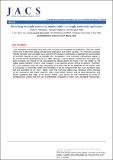Encoding multiple reactivity modes within a single synthetic replicator
Date
24/06/2020Metadata
Show full item recordAbstract
Establishing instructable and self-sustaining replication networks in pools of chemical reagents is a key challenge in systems chemistry. Self-replicating templates are formed from two constituent components with complementary recognition and reactive sites via a slow bimolecular pathway and a fast template-directed pathway. Here, we re-engineer one of the components of a synthetic replicator to encode an additional recognition function, permitting the assembly of a binary complex between the components that mediates replicator formation through a template-independent pathway, which achieves maximum rate acceleration at early time points in the replication process. The complementarity between recognition sites creates a key conformational equilibrium between the catalytically inert product, formed via the template-independent pathway, and the catalytically active replicator that mediates the template-directed pathway. Consequently, the rapid formation of the catalytically inert isomer “kickstarts” replication through the template-directed pathway. Through kinetic analyses, we demonstrate that the presence of the two recognition-mediated reactivity modes results in enhanced template formation in comparison to systems capable of exploiting only a single recognition-mediated pathway. Finally, kinetic simulations reveal that the conformational equilibrium and both the relative and absolute efficiencies of the recognition-mediated pathways affect the extent to which self-replicating systems can benefit from this additional template-independent reactivity mode. These results allow us to formulate the rules that govern the coupling of replication processes to alternative recognition-mediated reactivity modes. The interplay between template-directed and template-independent pathways for replicator formation has significant relevance to ongoing efforts to design instructable and adaptable replicator networks.
Citation
Robertson , C C , Kosikova , T & Philp , D 2020 , ' Encoding multiple reactivity modes within a single synthetic replicator ' , Journal of the American Chemical Society , vol. 142 , no. 25 , pp. 11139–11152 . https://doi.org/10.1021/jacs.0c03527
Publication
Journal of the American Chemical Society
Status
Peer reviewed
ISSN
0002-7863Type
Journal article
Description
Financial support for this work was provided by the University of St Andrews and EaStCHEM, Northwestern University, and the Engineering and Physical Sciences Research Council (Grant EP/K503162/1).Collections
Items in the St Andrews Research Repository are protected by copyright, with all rights reserved, unless otherwise indicated.

